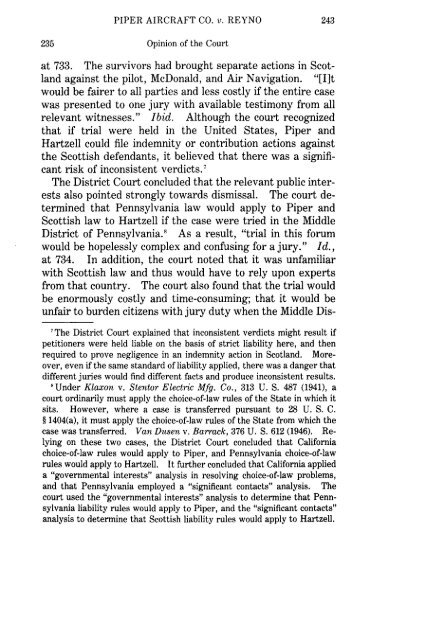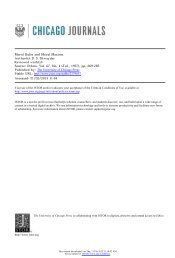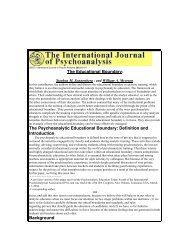Karayanni.FN023.Piper Aircraft v. Reyno.pdf - The University of ...
Karayanni.FN023.Piper Aircraft v. Reyno.pdf - The University of ...
Karayanni.FN023.Piper Aircraft v. Reyno.pdf - The University of ...
Create successful ePaper yourself
Turn your PDF publications into a flip-book with our unique Google optimized e-Paper software.
PIPER AIRCRAFT CO. v. REYNO235 Opinion <strong>of</strong> the Courtat 733. <strong>The</strong> survivors had brought separate actions in Scotlandagainst the pilot, McDonald, and Air Navigation. "[I]twould be fairer to all parties and less costly if the entire casewas presented to one jury with available testimony from allrelevant witnesses." Ibid. Although the court recognizedthat if trial were held in the United States, Piper andHartzell could file indemnity or contribution actions againstthe Scottish defendants, it believed that there was a significantrisk <strong>of</strong> inconsistent verdicts. 7<strong>The</strong> District Court concluded that the relevant public interestsalso pointed strongly towards dismissal. <strong>The</strong> court determinedthat Pennsylvania law would apply to Piper andScottish law to Hartzell if the case were tried in the MiddleDistrict <strong>of</strong> Pennsylvania. 8 As a result, "trial in this forumwould be hopelessly complex and confusing for a jury." Id.,at 734. In addition, the court noted that it was unfamiliarwith Scottish law and thus would have to rely upon expertsfrom that country. <strong>The</strong> court also found that the trial wouldbe enormously costly and time-consuming; that it would beunfair to burden citizens with jury duty when the Middle Dis-'<strong>The</strong> District Court explained that inconsistent verdicts might result ifpetitioners were held liable on the basis <strong>of</strong> strict liability here, and thenrequired to prove negligence in an indemnity action in Scotland. Moreover,even if the same standard <strong>of</strong> liability applied, there was a danger thatdifferent juries would find different facts and produce inconsistent results.'Under Klaxon v. Stentor Electric Mfg. Co., 313 U. S. 487 (1941), acourt ordinarily must apply the choice-<strong>of</strong>-law rules <strong>of</strong> the State in which itsits. However, where a case is transferred pursuant to 28 U. S. C.§ 1404(a), it must apply the choice-<strong>of</strong>-law rules <strong>of</strong> the State from which thecase was transferred. Van Dusen v. Barrack, 376 U. S. 612 (1946). Relyingon these two cases, the District Court concluded that Californiachoice-<strong>of</strong>-law rules would apply to Piper, and Pennsylvania choice-<strong>of</strong>-lawrules would apply to Hartzell. It further concluded that California applieda "governmental interests" analysis in resolving choice-<strong>of</strong>-law problems,and that Pennsylvania employed a "significant contacts" analysis. <strong>The</strong>court used the "governmental interests" analysis to determine that Pennsylvanialiability rules would apply to Piper, and the "significant contacts"analysis to determine that Scottish liability rules would apply to Hartzell.
















